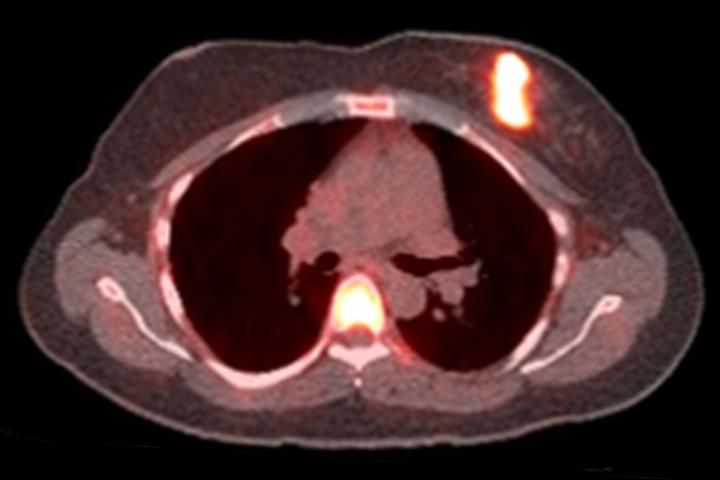PET Imaging Reveals Which Breast Cancer Patients Won’t Respond to Hormone Therapy
Hormone therapy is only effective in roughly half of estrogen receptor-positive cancers. Being able to identify patients that will not respond could save valuable treatment time.
The answer to whether hormone replacement therapy will work for a woman with breast cancer likely comes down to whether her estrogen receptors are working – a function that can be clearly seen via PET imaging.
Roughly 80 percent of the approximately 250,000 cases of breast cancer diagnosed annually in the United States are labeled as estrogen receptor-positive. Hormone therapy is commonly used to treat this group because it can impede estrogen’s effect on tumors. But, it only works in about half of cases, leaving providers wondering how to identify which women will benefit and who will not.
To help doctors figure out which patients are good hormone therapy candidates, a team of investigators from the Washington University School of Medicine at St. Louis launched a trial, and they discovered the treatment does not work in women with non-functional estrogen receptors.
“If breast cancer in a patient is estrogen receptor-positive, doctors will usually recommend hormone therapy even though they know it will only work for slightly more than half the patients,” said senior author Farrokh Dehdashti M.D., professor, senior vice chair, and division director of nuclear medicine at Washington’s Mallinckrodt Institute of Radiology. “When hormone therapy works, it’s typically quite effective, and it has milder side effects than some other therapies, and that’s why oncologists and patients want to try it first. But, we need to narrow down who is likely to benefit, and there really hasn’t been a reliable test to accomplish that.”
This is where Dehdashti’s team stepped in, building their study around the theory behind estrogen receptor functionality and the corresponding increase in the number of progesterone receptor molecules produced on the surface of cells when estrogen receptors are stimulated. They published their findings in the Feb. 2 Nature Communications.
Bright spots indicate that cancer cells have responded to a one-day challenge with estrogen in this positron emission tomography (PET) scan of a woman with breast cancer. In a small study, researchers at Washington University School of Medicine in St. Louis found that only women whose tumors responded to estrogen challenge benefited from hormone therapy. The findings could help doctors choose the treatments most likely to help their patients. CREDIT: Farrokh Dehdashti

The team used the imaging agent 21-18F fluorofuranylnorprogesterone (FFNP), created by co-author and University of Illinois chemist John Katzenellenbogen, Ph.D., Dehdashti’s team assessed via PET scan the number of progesterone receptors there are on the surface of a cancer cell. As the number of progesterone receptors increased, the PET signal also went higher, they said.
They made this discovery by recruiting 43 post-menopausal women with estrogen receptor-positive breast cancer. Most – 72 percent – had already received some type of therapy (largely hormone replacement therapy) prior to the study. Of the group, 86 percent had metastatic disease, and 14 percent had locally advanced or locally recurrent disease.
As a way to check estrogen receptor performance, the team performed PET scans with FFNP on every woman. They, then, administered three estrogen doses over 24 hours and re-scanned participants with PET the next day. Based on their analysis, they found PET signals in tumors of 28 woman increased significantly after estrogen exposure. The remaining 15 women saw little-to no change in the number of progesterone receptors.
All women received oncologist-recommended hormone therapy for six or more months, and, at follow-up, cancer was worse in the 15 women who had not responded to estrogen. Among the 28 who did, 13 had remained stable, and 15 had improved.
These results show, Dehdashti said, that it is possible to identify which patients will not receive any benefit from hormone therapy. Because earlier breast cancer treatment leads to better outcomes, these patients should bypass it and try other treatment options.
“The goal of therapy is to control or improve disease, so if the therapy is likely to be ineffective, it should not be given to a patient,” he said. “We observed 100-percent agreement between the response to estrogen challenge and the response to hormone therapy, even though the participants were on a variety of treatment regimens.”
It is anticipated, he said, that this identification method could work for other therapies that depend on functional estrogen receptors, offering valuable information to oncologists who are trying to decide the best treatment course for individual patients.
For more coverage based on industry expert insights and research, subscribe to the Diagnostic Imaging e-Newsletter here.
What is the Best Use of AI in CT Lung Cancer Screening?
April 18th 2025In comparison to radiologist assessment, the use of AI to pre-screen patients with low-dose CT lung cancer screening provided a 12 percent reduction in mean interpretation time with a slight increase in specificity and a slight decrease in the recall rate, according to new research.
The Reading Room: Racial and Ethnic Minorities, Cancer Screenings, and COVID-19
November 3rd 2020In this podcast episode, Dr. Shalom Kalnicki, from Montefiore and Albert Einstein College of Medicine, discusses the disparities minority patients face with cancer screenings and what can be done to increase access during the pandemic.
Can CT-Based AI Radiomics Enhance Prediction of Recurrence-Free Survival for Non-Metastatic ccRCC?
April 14th 2025In comparison to a model based on clinicopathological risk factors, a CT radiomics-based machine learning model offered greater than a 10 percent higher AUC for predicting five-year recurrence-free survival in patients with non-metastatic clear cell renal cell carcinoma (ccRCC).
Could Lymph Node Distribution Patterns on CT Improve Staging for Colon Cancer?
April 11th 2025For patients with microsatellite instability-high colon cancer, distribution-based clinical lymph node staging (dCN) with computed tomography (CT) offered nearly double the accuracy rate of clinical lymph node staging in a recent study.